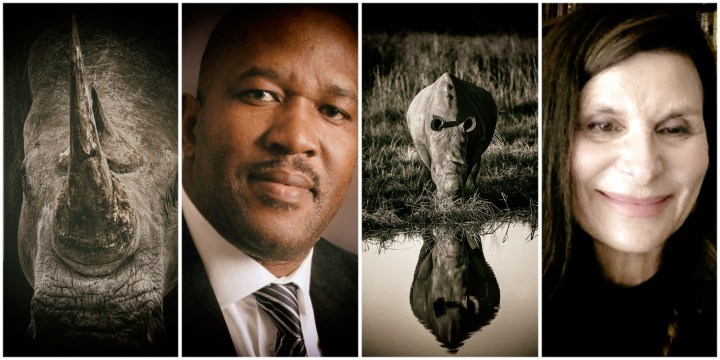POACHING CRISIS
SANParks executives say Kruger’s threatened rhino population ‘not too far’ from stability

In a webinar hosted by Our Burning Planet’s Don Pinnock and rhino conservationist Helena Kriel, Gareth Coleman, managing executive at the Kruger National Park, and Luthando Dziba, managing executive for Conservation Services at SANparks, sought to reorient the narrative about the park, lauding anti-poaching efforts and saying the rhino population is not too far from stabilising.
Gareth Coleman, managing executive at the Kruger National Park and Luthando Dziba, managing executive for Conservation Services at SANParks, lay much of the blame for the park’s financial malaise squarely with Covid-related restrictions and their impact on revenue. Dr Dziba also suggested that the point at which the trend of an ever-dwindling rhino population may be reversed, might not be too far away.
Our Burning Planet has previously reported that the Kruger’s operating budget has been cut by 66%, the Covid pandemic has culled tourist bookings and rhino numbers continue to drop. The same report continued that international crime syndicates are targeting the park with up to seven poaching groups operating daily and that in seven years from 2014 there were 19,154 logged poacher incursions — an average of 2,736 a year.
Dziba pointed to much of SANParks’ current financial malaise having its genesis in the coronavirus pandemic and associated lockdowns and restrictions on travel, saying that “international visitors to our national parks dropped by about 98% whereas local visitors dropped about 65%. Revenue in total dropped around 65% in the 2020/2021 financial year.”
“We’ve had a significant drop in our revenue and therefore, resources available for various activities including the ability to fill positions in places right across SANParks, not just Kruger, is something that we are coping with,” said Dziba.
In a statement released on Tuesday, the Department of Forestry, Fisheries and the Environment (DFFE) said, “a total of 451 rhino were poached in South Africa in 2021, 327 within government reserves and 124 on private property. While there is a 24% decrease in rhino poaching compared to the pre-Covid period in 2019, there has been an increase in poaching on private properties.”
The statement continued: “In 2021, 209 rhino were poached for their horns in South African National Parks – all in the Kruger National Park,” adding that “the steady decline in rhino poaching in Kruger Park is related to an increase in the intensity of anti-poaching activities in the Kruger National Park”. And, “targeted deployment of resources is being assisted by the roll-out of a CSIR-developed situational awareness platform known as CMORE into the integrated wildlife zones. Through this single technology platform all role players are able to collaborate, making use of real-time insights and analytical capability, linking, for example, camera traps and ranger patrols while integrating a range of other systems.”
In a seeming attempt to reorient a perception of the relative ineffectiveness of tens of millions of rands spent on anti-poaching efforts, Coleman expanded on this latter point in the webinar, lauding Kruger’s anti-poaching efforts and boldly asserting that the technology and efforts put in to secure the park put them head and shoulders above the rest of the world.
“Kruger probably has the most advanced anti-poaching techniques, operations, equipment, people, globally… The amount of resources that we put in… probably more than any other park in Africa.
“So we actually will be leaders in the area, we actually are coping relatively effectively well in a very difficult environment,” said Coleman as he explained that a major difference that Kruger had to contend with relative to other national parks was its sheer size.
“We’re proud that we have the best anti-poaching units, the best equipment, the best technologies… And that’s because of both the size and the nature of our conservation efforts.”
Dziba explained to webinar attendees that the impact of the poaching of females on the rhino population was substantial, saying that an average adult rhino female gave birth to between eight and 10 animals in its lifetime. Killing them had a ripple effect on the population. He said that they had been “selectively dehorning females in order to deter… the poaching of females”.
Dziba said that the Kruger Park is “not too far” away from a point where the rhino population will stabilise:
“I think what the minister or the department reported recently… shows that we have seen declines in the number of rhinos poached, and we will continue to see that, especially considering some of our investments and efforts.
“The day that I think we will be completely happy is when we start to see the population stabilising… and even growing…” OBP/DM





















 Become an Insider
Become an Insider
I watched the webinar last evening and my sympathy just went out to the two Sanparks executives. They are doing the best they can in incredibly difficult circumstances and the comments and questions that attendees were posing left me appalled at the ignorance and downright vitriol that was shown. KNP is a treasure and cannot be allowed to disintegrate. Money has to found somewhere and quickly to allow for the renewal and maintenance of infrastructure and to carry out all the conservation activities. There is so much goodwill towards the park that I think that a crowdfunding exercise in South Africa and overseas could easily produce a large enough sum to see then through until tourists return in numbers. Ezemvelo are in the same position as Sanparks and some of their conservation activities are being carried out by NPO’s such as WildlifeAct and the EWT. I personally have taken part in game counts. WE HAVE TO MAKE A PLAN
Kruger Park website:
‘ Rhino Poaching Statistics – Update 2021
Rhino numbers have decreased dramatically in Kruger National Park. According to recent rhino statistics, the rhino population in Kruger National Park has decreased by a staggering 60% since 2013. According to SANParks, there are only 3,529 white rhinos and 268 black rhinos left in Kruger National Park.
Rangers have recently voiced their frustration to the media about the courts taking too long to prosecute alleged rhino poachers who have been arrested. Many go free on bail only to commit more acts of rhino poaching.’
Am I missing something? Approx. half the no. of rhinos poached in 2021 were from the Kruger. Surely that means the ‘trend change’ is in the more distant future?
There is a strong correlation between the numbers of rhino poached and the declining population of these animals. There are fewer poached because there are fewer to poach. I tried to engage SANPARKS on some issues and was fobbed off. I posted on their Facebook site and within 24 hours, and 70 likes, the post was blocked by their moderator. Never an answer. There were issues at that stage with the closing downn of the court in Skukuza amidst allegations of staff involvement in poaching. Never an answer, never any consequences, only more well-funded staff. Those obstructing poaching were moved to outlying posts where rhinos are less common….. Trust is a huge issue to my mind. I can also mention that I have never had a response about my concerns of effects of elephant populations on biodiversity …… in the past 25 -odd years numbers have been allowed to grow despite their own science telling them it ids not sustainable for biodiversity.